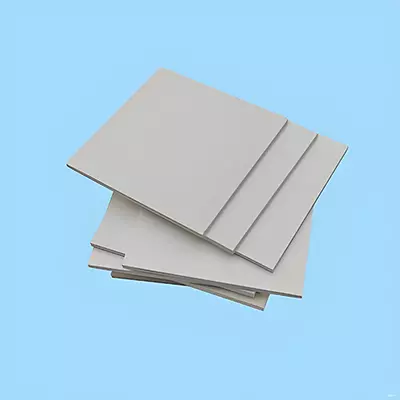From a technological perspective, boron nitride has emerged as a star in the future materials landscape precisely because it precisely addresses the most urgent thermal management demands of the high-end electronics industry.
Traditional high-fill silicone thermal pads primarily rely on plastic deformation and lack resilience. Over time, mismatched CTE (Coefficient of Thermal Expansion) can create voids, increasing thermal resistance. Boron nitride thermal pads overcome the triple challenge of balancing thermal conductivity, softness, and resilience. Even under high-fill conditions, they maintain long-term elasticity and stable thermal performance.

A Unique Combination of Properties: The “Thermal Conduction Champion” Among Insulators
Boron nitride's core advantage lies in defying the conventional wisdom that “high thermal conductivity must be accompanied by electrical conductivity,” achieving seemingly contradictory dual properties:
Unparalleled In-Plane Thermal Conductivity: Hexagonal boron nitride features a layered structure similar to graphene. Within its single-layer plane, phonons—the primary carriers of heat—move at high speeds with minimal resistance, yielding an in-plane thermal conductivity of 300–2000 W/(m·K). This figure rivals that of copper (approximately 400 W/(m·K)) and even surpasses it.
Experiments were conducted using the LW-9389 thermal conductivity tester, adhering to ASTM D5470 standards.
Sample preparation: 25.4mm × 25.4mm × 2mm specimens were placed flat on the test platform.
Test results are shown in the table below:
| Test Item | Test Data | |||
| Sample 1 | Sample 2 | Sample 3 | Average | |
| Thermal Conductivity (W/m·K) (@1.8mm) | 14.90 | 15.53 | 15.06 | 15.16 |
| Thermal Conductivity (W/m·K) (@1.6mm) | 12.98 | 13.19 | 13.24 | 13.13 |
| Thermal Conductivity (W/m·K) (@1.4mm) | 10.56 | 10.61 | 10.59 | 10.59 |
The experiment employed the LW-9389 thermal conductivity tester, adhering to the ASTM D5470 standard.
Sample preparation: 25.4mm × 25.4mm × 2mm specimens were placed flat on the test platform.
Test results are shown in the table below:
| Test Item | Test Data | Pressure(psi) | |||
| Sample | 10 psi | 20 psi | 30 psi | 40 psi | |
| 10~40Psi Step Thermal Resistance(℃*in²/W)@2mm | 1 | 0.197 | 0.188 | 0.186 | 0.196 |
| 2 | 0.188 | 0.183 | 0.181 | 0.196 | |
| 3 | 0.192 | 0.188 | 0.184 | 0.192 | |
| Average | 0.192 | 0.186 | 0.184 | 0.195 | |
| 10~40Psi Step Thermal Resistance(℃*in²/W)@2mm | 1 | 1.271 | 1.213 | 1.200 | 1.265 |
| 2 | 1.213 | 1.181 | 1.168 | 1.265 | |
| 3 | 1.239 | 1.213 | 1.187 | 1.239 | |
| Average | 1.241 | 1.202 | 1.185 | 1.256 | |
This dual property of thermal conductivity and electrical insulation makes boron nitride an almost irreplaceable choice in heat dissipation scenarios requiring strict electrical isolation.
Future Demand
Why now? The rapid advancement of 5G/6G communications, AI computing, and electric vehicles is pushing chips and power devices to the limits of thermal management. Traditional thermal materials are increasingly inadequate, while boron nitride (BN) has emerged to address several critical and rapidly growing application areas:
Advanced Chip Packaging: Requiring rapid heat dissipation from computing cores while maintaining insulation from densely packed interconnects, BN-based materials offer an ideal solution.
Next-generation power devices: High-frequency power components like silicon carbide and gallium nitride impose extreme demands on the insulation and thermal conductivity of packaging and substrate materials. Boron nitride's performance profile faces virtually no competition in this domain.
Flexible Electronics and Wearables: Materials must be flexible, lightweight, highly thermally conductive, and insulating. Boron nitride nanosheets or composite films demonstrate immense potential in this domain.
Opportunities and Challenges Coexist: Sheen Technology's R&D Perspective
We fully recognize that boron nitride still faces challenges on its path to large-scale industrialization—precisely the fortress material developers must conquer.
The primary constraints currently lie in its high cost and complex synthesis process, resulting in a price significantly higher than traditional fillers like alumina. Furthermore, in composite applications, achieving efficient thermal conduction pathways often requires high filler ratios (>50%). However, this sacrifices processability and mechanical toughness, making the material brittle and difficult to form.
Yet this is precisely where opportunity lies. At Sheen Technology, we view these challenges as catalysts for innovation. Researchers worldwide, including our team, are pursuing breakthroughs through two key avenues:
Process Innovation: Developing more economical and efficient synthesis methods to reduce production costs.
Structural Design: Constructing microstructures like 3D B4N networks and vertically oriented arrays to achieve higher thermal conductivity with lower fillers while preserving the composite's workability and flexibility.
With its unique combination of high thermal conductivity and electrical insulation, boron nitride is far more than a precious laboratory sample—it is a strategic material precisely aligned with the future demands of high-end electronics.
While challenges in cost and manufacturing processes remain, its immense potential is undeniable. As a trailblazer in thermal management, Sheen Technology is actively engaged in the R&D wave of boron nitride and related composites. We believe that with continuous technological breakthroughs, boron nitride will inevitably evolve from a “material of the future” into a “pillar of reality.”

 English
English
 usheenthermal
usheenthermal



